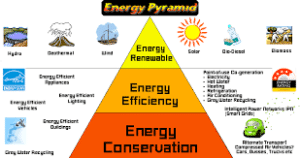Ways to Save Home Energy
Your home is full of phantom loads that, although tiny on their own, collectively consume significant amounts of electricity over a year’s time. When I first moved into my solar home, I discovered that there were about 125 watts of cumulative ghost loads. That’s the equivalent of two 60-watt light bulbs running 24 hours a day, 365 days a year!
Other examples of phantom loads include the power adapters (that heavy little box right by the power plug) for cordless phones, answering machines and keyboards; microwave ovens and coffee makers equipped with LED clocks; stereos, radios, audio receivers, satellite receivers and power strips; even hard-wired smoke detectors and some GFIs (the electrical outlets with built-in circuit breakers). And don’t forget your cell phone charger; it may draw power even when the phone isn’t hooked in or after the phone is fully charged.

You can gradually reduce your energy consumption by making your home more efficient and simply avoiding wasteful use of electricity. The goal isn’t to live without conveniences, but to live wisely.
Energy conservation entails two separate but complementary strategies: frugality and efficiency. Frugality involves behaviors or actions that reduce energy use — turning off lights, televisions and stereos in unoccupied rooms and taking shorter showers to reduce hot water use are good examples.
The efficiency principle, on the other hand, calls on us to wring as much useful energy as possible from our energy supplies; examples include adding insulation to our attics or purchasing energy-efficient appliances. The savings can be quite significant.
Some utilities offer financial incentives to customers for energy efficiency measures they undertake. Why? Because by reducing the demand for electricity, local utilities can reduce their need for additional capacity. They may even avoid the need to build expensive new power plants.
Homes account for about one-fifth of the United States’ total annual energy demand. Heating and cooling the interior of our homes consumes the largest portion of residential energy — about 44 percent. Lighting, cooking and appliances (other than the refrigerator) consume one-third of our energy. Water heating consumes 14 percent and the refrigerator about 9 percent. Although each home is different, this data alerts us to the big energy consumers, and can help us target the greatest potential savings.
More Ways to Save Home Energy
Choose efficient appliances. You can achieve huge reductions in energy consumption by replacing energy-consuming appliances and other devices — especially heating and cooling equipment, water heaters, refrigerators and washing machines — with newer, energy-efficient models. The job is a lot easier with consumer labels required by the U.S. and Canadian governments, which list pertinent energy data on each model. Energy Star labels indicate the best choices.
Choose efficient lights. One of the easiest ways to reduce energy bills in our homes is to install compact fluorescent light bulbs (CFLs), which convert about 20 percent of the electricity flowing through them into light. A standard incandescent light bulb converts only 5 percent of the electricity flowing through it into light. CFLs come in several different shapes and sizes, so they fit into a wide variety of light fixtures and lamps. Compact fluorescents are currently the hands-down favorites when it comes to energy efficiency, although they may be replaced by more efficient light emitting diode (LED) lights in the not-too-distant future.
Save hot water. If your water heater is old and decrepit, replace it with an energy-efficient model. You should consider an on-demand or instantaneous water heater, which is a larger initial investment, but will save energy (and money in the long run).
If your water heater still has a few good years left, you can cut fuel bills by making a few adjustments. The first thing you should do is check the water temperature. To do this, turn on the hot water and let it run for a minute or two. Next, hold a thermometer under a faucet. If the temperature is above 120 degrees Fahrenheit, turn the water heater’s temperature down. Studies show that you don’t need water to be hotter than 120 degrees to wash dishes and clothes. This is sufficient to kill bacteria.
If you have a gas- or propane-powered water heater, simply turn the dial on the unit to a lower setting, then wait a day or two and check the temperature again. If the temperature is still too high, lower it again. For electric water heaters, you’ll need to remove the top and bottom covers on the side of the unit, one for each heating element, and turn the temperature settings down using a screwdriver.
After lowering the water temperature setting, you should install an insulated water heater blanket over the tank. Water heater blankets cost as little as $15, and pay for themselves in less than a year, depending on your family’s hot water consumption. You can also save hot water by installing water-efficient shower heads.
Eliminate phantom loads. Phantom loads (also called vampire or ghost loads) are the electricity used by appliances and other electronic devices when they’re not in active use. Your instant-on television, for example, consumes electricity even when it’s off. Why? To keep the circuits buzzing, so that when you click the power button on the remote, the TV hums to life instantly.
Other examples of phantom loads include the power adapters (that heavy little box right by the power plug) for cordless phones, answering machines and keyboards; microwave ovens and coffee makers equipped with LED clocks; stereos, radios, audio receivers, satellite receivers and power strips; even hard-wired smoke detectors and some GFIs (the electrical outlets with built-in circuit breakers). And don’t forget your cell phone charger; it may draw power even when the phone isn’t hooked in or after the phone is fully charged.
Your home is full of phantom loads that, although tiny on their own, collectively consume significant amounts of electricity over a year’s time. When I first moved into my solar home, I discovered that there were about 125 watts of cumulative ghost loads. That’s the equivalent of two 60-watt light bulbs running 24 hours a day, 365 days a year!
I set out to eliminate the phantoms from my life, and so can you. Make a note of each phantom load, and then devise a strategy to get rid of them one by one. For example, you can plug televisions, stereos, microwaves and similar electronic devices into power strips that can be switched off easily when the electronic device or appliance is not in use.
You can gradually reduce your energy consumption by making your home more efficient and simply avoiding wasteful use of electricity. The goal isn’t to live without conveniences, but to live wisely.



